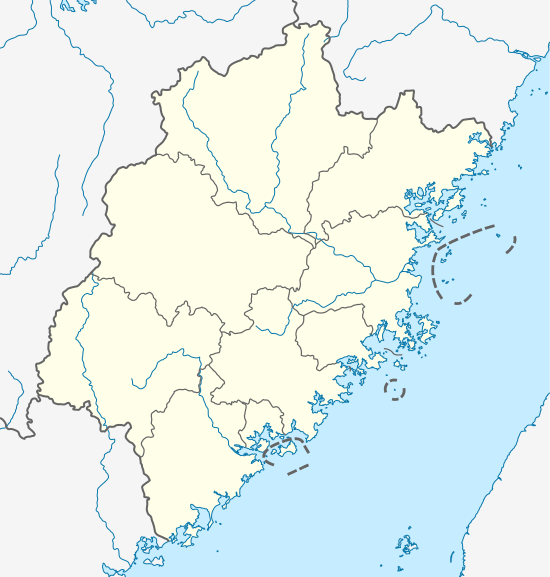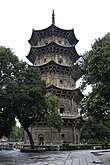Kaiyuan Temple (Quanzhou)
| Kaiyuan Temple | |
|---|---|
| 開元寺 | |
 The Hall of Mahavira at the Kaiyuan Temple | |
 Shown within Fujian  Kaiyuan Temple (Quanzhou) (China) | |
| Basic information | |
| Geographic coordinates | 24°55′00″N 118°34′52″E / 24.9168°N 118.5810°ECoordinates: 24°55′00″N 118°34′52″E / 24.9168°N 118.5810°E |
| Affiliation | Buddhism |
| District | Licheng |
| Prefecture | Quanzhou |
| Province | Fujian |
| Country | China |
| Website | http://www.qzdkys.com/ |
| Architectural description | |
| Architectural style | Chinese architecture |
| Founder | Huang Shougong (黄守恭) |
| Date established | 686 |
| Completed | 686 |
| Site area | 78,000 |
Kaiyuan Temple (simplified Chinese: 开元寺; traditional Chinese: 開元寺; pinyin: Kaīyuán Sì; Pe̍h-ōe-jī: Khai-gôan-sī) is a Buddhist temple in West Street, Quanzhou, China, the largest in Fujian province with an area of 78,000 square metres (840,000 sq ft).[1][2] Although it is known as a "Hindu-Buddhist temple", on account of added Tamil-Hindu influences, the main statue in the most important hall is that of Vairocana Buddha, the main Buddha according to Huayan Buddhism. What is now called the Mahavira Hall (Mahavira = the Great and Strong) is in fact the Vairocana Hall.
History
It was originally built in 685 or 686 during the Tang dynasty (618–907). The temple situated in the Mulberry garden of landlord Huang Shougong (黄守恭) who was said to dream of a monk begging land from him for building a temple. He donated his garden and changed it into a temple with the name of "Lotus Temple" (莲花寺). In 738 in the Tang dynasty, it was renamed "Kaiyuan Temple", which is still in use now.[1][3]
Behind its main hall "Mahavira Hall", there are some columns with fragments from a Shiva temple built in 1283 by the Tamil community in Quanzhou dedicated to Hindu God Shiva. The carvings are dispersed across five primary sites in Quanzhou and the neighboring areas. They were made in the South Indian style, and share close similarities with 13th-century temples constructed in the Chola Nadu region in Tamil Nadu. Nearly all of the carvings were carved with greenish-gray granite, which was widely available in the nearby hills and used in the region's local architecture.[4] In 1983, the Kaiyuan Temple was designated as a national temple.
Architecture
Along the central axis are the Four Heavenly Kings Hall, Mahavira Hall, Sweet Dew Altar of Precepts and Buddhist Texts Library. There are over 10 halls and rooms on both sides, including Tanyue Ancestral Temple, Virtue Hall and Zunsheng Hall.[5]
Hall of Four Heavenly Kings
The Hall of Four Heavenly Kings was built in the Tang dynasty (618–907). It serves as the Shanmen of the temple. In front of the hall, a wooden plaque with a couplet is hung on the hall. It says "Here is the so called Buddha State, the street are all Saints" (此地古称佛国,满街都是圣人). It was composed by Song dynasty scholar Zhu Xi and inscribed by eminent monk Hong Yi.[6]
Mahavira Hall
The Mahavira Hall was originally built in 686 in the Tang dynasty (618–907) and the extant buildings are relics of the late Ming dynasty (1368–1644). It is 20-metre (66 ft) high, 9 rooms wide, 6 rooms deep and covers an area of 1,387.75-square-metre (14,937.6 sq ft). The hall preserved the majestic and impressive architectural style of the Tang dynasty. The gilded copper statue of Vairocana in enshrined in middle of the hall with four statues of Buddha made in the Five dynasties (907–960). They are known as "Five Buddha".[7][8]
Zhenguo Pagoda
Zhenguo Pagoda (镇国塔) is a five-story wooden pagoda first built in 865 in the Tang dynasty (618–907). But it was destroyed and rebuilt into stone pagoda in 1238 in the Song dynasty (960–1276). The 48.24-metre (158.3 ft) pagoda was octagonal with five stories. Every story is carved with sixteen reliefs with a total of 80 vivid human figures.[9][10]
Renshou Pagoda
The Renshou Pagoda (仁寿塔) was built in 917 in the Later Liang dynasty (907–923). In 1114 in the Song dynasty, it was renamed "Renshou Pagoda" by the Emperor Huizong. It is 44.06-metre (144.6 ft) high and has the similar with the Zhenguo Pagoda.[9]
Sweet Dew Altar of Precepts
The Sweet Dew Altar of Precepts (甘露戒坛) is used for Buddhist believers to ordain the precepts. The caisson (藻井) above the altar which applies the Ruyi brackets has complex and sophisticated structure. Among the brackets of the pillars around the altar, 24 statues of Flying Apsaras with five-color streamers are erected. They are holding musical instruments like pipa, two-stringed fiddle, castanet and etc. and dancing elegantly and vividly. A wood carving sitting Ming dynasty statue of Rocana is placed on the altar. The lotus throne he sits has a thousand lotus petals, each of which is engraved with a 6-centimetre (2.4 in) statue of Buddha.[11][12]
Gallery
 Zhenguo Pagoda
Zhenguo Pagoda_20170727.jpg) Reshou Pagoda
Reshou Pagoda 甘露戒坛
甘露戒坛 藏经阁
藏经阁
References
| Wikimedia Commons has media related to Kaiyuan Temple (Quanzhou). |
- 1 2 Zi Yan (2012), p. 93.
- ↑ "Kaiyuan Temple". Chinaculture.org. Retrieved 31 January 2012.
- ↑ Zhang Yuhuan (2012), p. 184.
- ↑ Lee, Risha (2009). "Rethinking Community: the Indic Carvings of Quanzhou". In Kulke, Hermann; Kesavapany, K.; Sakhuja, Vijay. Nagapattinam to Suvarnadwipa: reflections on Chola naval expeditions to Southeast Asia. Institute of Southeast Asian Studies. p. 240. ISBN 978-981-230-936-5.
- ↑ Zi Yan (2012), p. 94.
- ↑ Zi Yan (2012), p. 93–94.
- ↑ Zi Yan (2012), p. 94–95.
- ↑ Zhang Yuhuan (2012), p. 185.
- 1 2 Zi Yan (2012), p. 96.
- ↑ Zhang Yuhuan (2012), p. 191.
- ↑ Zi Yan (2012), p. 97.
- ↑ Zhang Yuhuan (2012), p. 190.
Bibliography
- Zi Yan (2012). Famous Temples in China (in English and Chinese). Hefei, Anhui: Huangshan Publishing House. ISBN 978-7-5461-3146-7.
- Zhang Yuhuan (2012). "Housing Rarely Stone Pillars of Ancient Indian Brahmanism: Quanzhou Kaiyuan Temple" 《拥有罕见的古印度婆罗门教石柱:泉州开元寺》. 《图解中国著名佛教寺院》 [Illustration of Famous Buddhist Temples in China] (in Chinese). Beijing: Contemporary China Publishing House. ISBN 978-7-5154-0135-5.